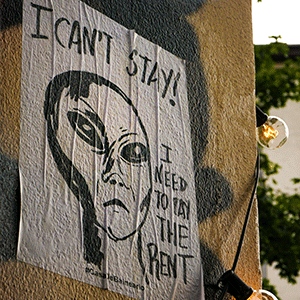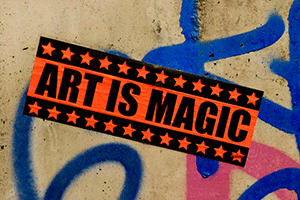Art in Kreuzberg: A Living, Breathing Creature of Creativity
Our Kreuzberg is not short of Bohemian spirit and cultural diversity, and it has long been a hub for artistic expression. The neighbourhood’s vibrant art scene is deeply rooted in its history, its multicultural community, and its enduring status as a haven for creatives. From street art that tells the stories of its residents to cutting-edge galleries showcasing avant-garde works, Kreuzberg offers a kaleidoscope of artistic experiences that captivate locals and visitors alike.
Everyone with have their own opinions, but these are our current top five must-see art destinations in Kreuzberg.
- 1: East Side Gallery: A series of murals painted directly on a 1,316 m long restored remnant of the Berlin Wall, situated just a ten-minute walk from our Hostel-Hotel to Mühlenstraße. (OK, it is a few meters inside neighbouring Friedrichshain, but you get the picture…)
- 2. Nordenhake Gallery: Known for its contemporary art exhibitions, this gallery features both established and emerging artists. You can find it at Lindenstraße 34, 10969 Berlin.
- 3. Carlier/Gebauer: This gallery showcases modern and experimental installations, photography, paintings, and drawings. The address is Markgrafenstraße 67, 10969 Berlin.
- 4. Berlinische Galerie: This museum and gallery hosts a collection of art created in Berlin from 1870 to the present day. It’s located at Alte Jakobstraße 124-128, 10969 Berlin.
- 5. König Galerie: Situated in a former church, this gallery focuses on contemporary art and has a beautiful architectural setting Make your way to Alexandrinenstraße 118, 10969 Berlin.
We hope you enjoy getting to know these locations! If you need more information or have any other questions, please feel free to ask at our reception.
A Historical Canvas
The art scene in Kreuzberg is inseparable from its history. During the Cold War, Kreuzberg was situated near the Berlin Wall, becoming a space of resistance and cultural defiance. Artists flocked to the area, attracted by low rents and a thriving underground scene. This legacy persists today, with Kreuzberg remaining a magnet for those seeking inspiration outside mainstream conventions.
The district’s history is reflected in its art, particularly its murals and graffiti. Our favourite remains the iconic East Side Gallery (above), a stretch of the Berlin Wall adorned with expressive murals, begins just on the edge of Kreuzberg. This open-air gallery, featuring works by artists from around the world, serves as a powerful reminder of the city’s divided past and the unifying power of art.
Street Art: The DNA of Kreuzberg
Kreuzberg’s streets are an open-air art space. Renowned for its street art, the district boasts works from both local and international artists.
Walking through Kreuzberg, visitors encounter vibrant murals, thought-provoking stencils, and intricate wheat-paste posters that reflect the area’s political, social, and cultural ethos.
Street art tours, often led by local artists, provide a deeper understanding of these works and their significance. These tours not only highlight the artistic techniques but also delve into the stories behind the pieces, offering insights into Kreuzberg’s unique cultural fabric.
“F*ck Art, Let’s Dance”: The Counter-Culture Spirit
The phrase “F*ck Art, Let’s Dance” encapsulates the rebellious and hedonistic spirit that is woven into Kreuzberg’s creative identity. Emerging from the punk and counter-culture movements of the late 1970s and 1980s, the slogan rejected stuffy, highbrow notions of art in favour of raw, unfiltered expression. It became a mantra for those who found meaning and connection in music, dance, and nightlife rather than conventional artistic frameworks.
In Kreuzberg, this ethos is alive and well. The district’s nightclubs, alternative spaces, and pop-up art events blur the lines between art, performance, and celebration, reflecting a community that values lived experiences as much as creative output. This philosophy continues to influence the art scene, making Kreuzberg a beacon for those seeking to embrace art in all its forms.
Galleries: A Hub for Contemporary Art
While street art is undoubtedly a cornerstone of Kreuzberg’s artistic identity, the district is also home to an array of galleries that showcase contemporary art in all its forms. Institutions like the Künstlerhaus Bethanien provide a platform for emerging and established artists to experiment and exhibit their works. Housed in a former hospital, this space hosts residencies and exhibitions, fostering a vibrant exchange between artists and the community.
Another notable venue is the Urban Spree Gallery, which bridges the gap between street art and contemporary gallery culture. Located in a sprawling industrial space, Urban Spree hosts exhibitions, workshops, and events, making it a dynamic hub for the local and international art scene.
The Galerie Barbara Weiss, known for its focus on feminist and socially engaged art, and the Kreuzberg Pavillon, an experimental project space, further enrich the district’s gallery offerings.
Even at the Fabrik Hostel Hotel, we have been keen to get involved, repurposing other otherwise featureless white walls as show space, especially during the pandemic.
What we all have in common is that we are challenging traditional notions of art, encouraging dialogue and interaction between creators and audiences.
As Kreuzberg continues to evolve, its art scene remains a vital force, adapting to new challenges and opportunities. Relentless gentrification and rapidly rising rents pose threats to the neighbourhood’s artistic identity, but local initiatives and community-driven projects strive to preserve its creative spirit. Artists, activists, and residents work together to ensure that Kreuzberg remains a place where art can thrive, accessible to all.
The district’s commitment to sustainability and inclusion is also shaping its future. Eco-friendly art projects and workshops focusing on repurposed materials are becoming increasingly popular, reflecting a broader shift towards socially and environmentally conscious creativity.
The goose that laid the golden egg
 However, there are dark clouds on the horizon; the proposed funding cuts to Berlin’s arts finances have sparked significant concern and backlash from the cultural community. The Berlin Senate plans to cut around €130 million from the arts budget for 2025, which is about 12% of its current allocation. This reduction could have a substantial impact on various cultural institutions, including operas, concert halls, museums, and the vibrant club scene.
However, there are dark clouds on the horizon; the proposed funding cuts to Berlin’s arts finances have sparked significant concern and backlash from the cultural community. The Berlin Senate plans to cut around €130 million from the arts budget for 2025, which is about 12% of its current allocation. This reduction could have a substantial impact on various cultural institutions, including operas, concert halls, museums, and the vibrant club scene.
Many fear that this vandalism by any other name will lead to job losses, reduced programming, and even the closure of some cultural institutions. The cuts are seen as a threat to Berlin’s status as a creative melting pot, with potential long-term effects on the city’s cultural vibrancy and diversity.
And with good reason. Even Joe Chialo, Berlin’s senator for culture, has called the cuts “drastic and brutal” and said he will fight to reduce their impact. There is a strong argument to be made that we need to not just reduce that impact, rather that reversing it is vital; the arts are at the heart of what makes Berlin so uniquely liveable, underpinning the social and economic magnetism which have been the bedrock of the city’s transformation from the basket-case it was during much of the second half of the twentieth century to the global destination which we have now become.
Indeed, there’s a strong movement against these cuts, with protests and actions organised under the hashtag #BerlinistKultur to draw attention to and resist the inevitable consequences. Cultural leaders and organisations are lobbying hard for the preservation of funding to maintain the city’s kaleidoscopic identity.
In these turbulent times when progress is under relentless attack from every quarter, Berlin wouldn’t also be insane enough to kill the creative goose that laid the golden egg, would we?




